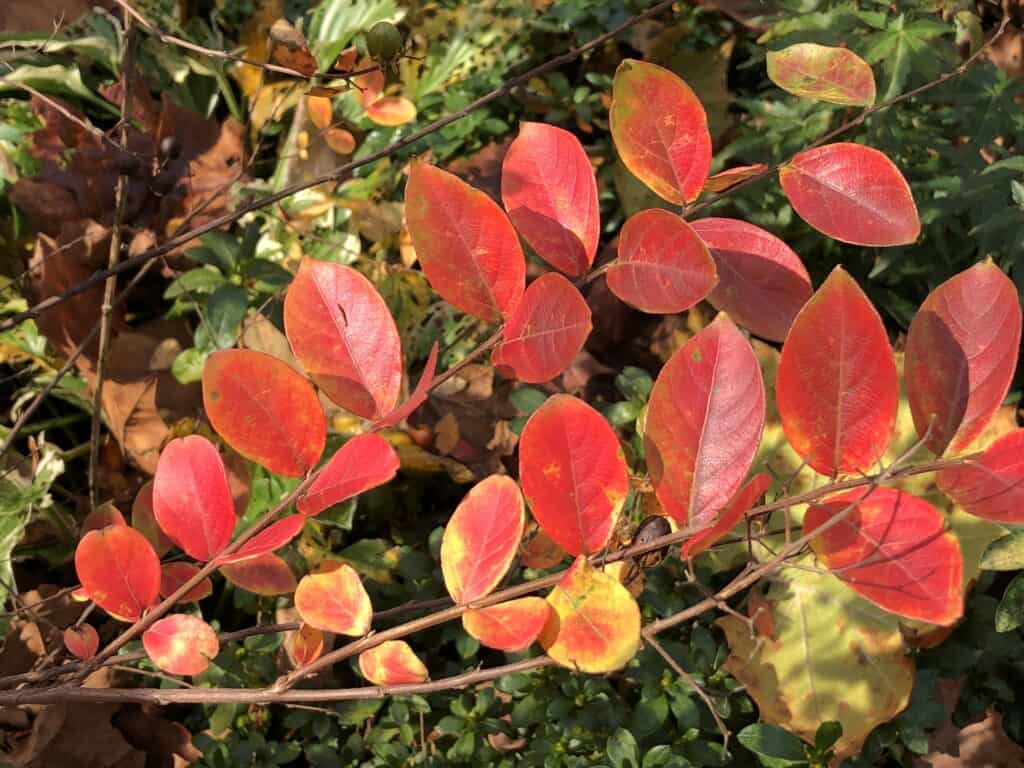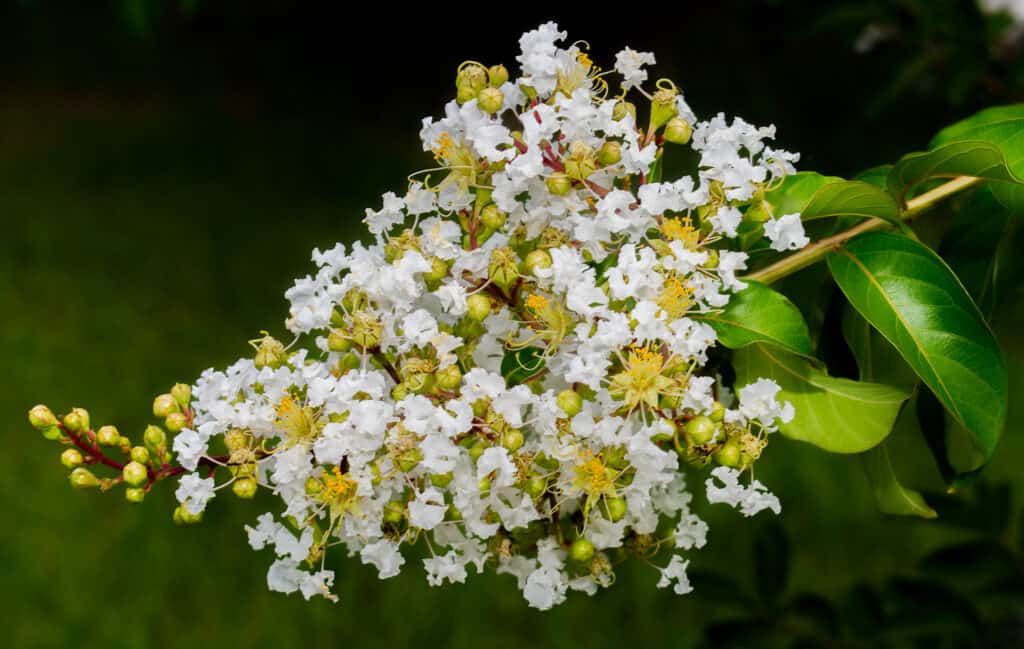If you’re interested in showy, low-maintenance landscape shrubs and trees that thrive in sunny, warm climates, you may have come across crape myrtles. These lovely plants are beloved for their interesting bark, gorgeous blooms, lovely growing habits, and array of pretty fall foliage.
Read on to learn about the differences and the similarities between the Acoma crape myrtle and the Natchez crape myrtle: how they differ in plant characteristics, landscape uses, hardiness, and flowering seasons.
Acoma Crape Myrtle vs. Natchez Crape Myrtle: A Quick Look
| Acoma Crape Myrtle | Natchez Crape Myrtle | |
|---|---|---|
| Plant Classification | Scientific Name: Lagerstroemia x ‘Acoma’ | Scientific Name: Lagerstroemia x ‘Natchez’ |
| Physical Description | Grows 10-15 feet tall by 6-10 feet wide at maturity. Deciduous. Features pale, peeling bark. vase-shaped, multi-trunked. Symmetrical crown that is particularly wide and umbrella shaped. Produces dense 6-12-inch clusters of strikingly white flowers. Fall foliage is purple-red. | Grows to 25-30 feet tall by 15-25 feet wide at maturity. Deciduous. Features an interesting red-brown peeling bark. Vase-shaped, multi-trunked. Symmetrical crown. Produces dense 6-12-inch clusters of white flowers. Fall foliage is orange-red. |
| Ideal Growing Conditions and Hardiness | Prefers at least 6-8 hours of full sun a day. Thrives in well-draining sandy, loamy, and clay soils that are acidic or slightly alkaline. High drought tolerance once established. Resistant to powdery mildew. Thrives in USDA growing Zones 7-9. | Prefers at least 6-8 hours of full sun a day. Thrives in well-draining sandy, loamy, and clay soils that are acidic or alkaline. High drought tolerance once established. Outstanding resistance to powdery mildew. Thrives in USDA growing Zones 7-10. |
| Landscape Use | Favored for use in yards and urban areas such as medians, parks, sidewalks, and parking lots. Can prune into a very small tree or large bush. | Favored for use in yards and urban areas such as medians, parks, sidewalks, and parking lots. |
| Flowering Season | Flowers from the end of June through the end of September | Flowers from the end of June until first frost. |
Acoma Crape Myrtle vs. Natchez Care Myrtle: Plant Classification
The Acoma and Natchez crape myrtles are both hybrid plant members of the same genus, Lagerstroemia. As hybrids, these crape myrtles are crosses between two species of crape myrtles. They belong to the Lythraceae family of flowering plants, which includes 620 species of herbs, shrubs, and trees. Indigenous to the Indian subcontinent, Southeast Asia and Northern Australia, crape myrtles are now grown as landscape plants in warm, sunny climates around the world.
Physical Description
While both Acoma and Natchez crape myrtles are vase-shaped, multi-trunked plants that produce showy white blooms, they differ significantly in height and width at maturity. While Acoma myrtles reach about 10-15 feet tall at maturity with a 6-10 foot spread, the much larger Natchez myrtle can reach heights of 25-30 feet at maturity with a 15-25 foot spread. Comparing these two varieties at maturity, noting their sizes is one of the quickest ways to distinguish the plants from each other.
Additionally, the Natchez crape myrtle is known for its unique red-brown peeling bark, which provides interest in a winter landscape. The Acoma variety, on the other hand, has a less distinctive, pale bark.
Both plants produce showy white flowers that grow in 6-12 inch upright, dense clusters that accent the symmetrical crowns of the myrtles. The Acoma crape myrtle, however, has a crown that is a bit more umbrella-shaped than the Natchez variety.
During the fall, look at the different colors of foliage to tell these two crape myrtle varieties apart. Typically, you’ll find that the Acoma crape myrtle features red-purple foliage in the fall, while the Natchez variety displays orange-red Autumn foliage.

Crape myrtles display vivid foliage in the fall, like this Acoma crape myrtle.
Acoma Crape Myrtle vs. Natchez: Ideal Growing Conditions and Hardiness
Overall, these crape myrtles have similar growing preferences and hardiness to pests and diseases. However, they do differ slightly in soil pH requirements and disease resistance.
Both varieties can thrive in a wide range of soil types provided it is well-draining, and they both need to grow in full sunlight.
The Natchez crape myrtle prefers well-drained clay, loamy, or sandy soil that is alkaline or acidic. The Acoma variety has similar soil preferences except for its tolerance to alkaline soil is a bit lower than that of the Natchez crape myrtle.
The Acoma myrtle also has a slightly more limited growing zone. Its USDA hardiness Zone range is 7-9, compared to the Natchez variety’s USDA growing Zones 7-10.
The final major difference between these two crape myrtles’ hardiness is their resistance to diseases. Both are notably hardy plants that are resistant to drought, common pests, and plant diseases. However, the Natchez crape myrtle is particularly disease and pest resistant with outstanding resistance to powdery mildew- a common disease that can affect crape myrtles.
Landscape Uses
As deciduous plants, these crape myrtles aren’t great candidates to use for privacy screening. However, they make great landscape plants for their showy, gorgeous blooms, beautiful fall foliage, interesting bark, and lovely growing habits. Due to their ability to grow in limited spaces ,and to thrive in difficult soil conditions, these crape myrtles are often planted in urban areas such as parking lots, medians, sidewalks, and small parks.
When choosing between which of these varieties to plant, the main point to consider is the height and spread of each variety at maturity. As previously mentioned, the Natchez crape myrtle can reach heights of 25-30 feet at maturity with a 15–25-foot spread. As such, it’s imperative to make sure you plant this tree where it will have the necessary vertical and lateral space to grow.
If you’re looking to plant a couple of small crape myrtles along the front line of your house, the Acoma variety will likely be a more suitable choice due to its significantly smaller size. Depending on how you prune the Acoma crape myrtle, it can grow as a shrub or small tree. If you’re interested in planting a tree with interesting features and showy blooms in a large yard, then the Natchez variety may be perfect.
Acoma Crape Myrtle vs. Natchez: Flowering Season
If you’re looking for plants that produce wonderfully showy, interesting blooms all summer long, then both of these crape myrtle varieties could be excellent choices. They start blooming around the beginning of summer and continue until fall. In line with its overall hardier characteristics, however, the Natchez variety tends to bloom until the first frost compared to the Acoma variety, which blooms until early fall.

The Natchez crape myrtle blooms through the summer.
©iStock.com/Dan Rieck
Up Next:
- Wax Myrtle vs. Crepe Myrtle
- Red Dragon Japanese Maple vs. Crimson Queen
- Discover the 12 Fastest Growing Trees You Can Plant
The photo featured at the top of this post is © iStock.com/Dan Rieck
Sources
- ufl.edu, Available here: https://edis.ifas.ufl.edu/publication/ST343
- ufl.edu, Available here: https://edis.ifas.ufl.edu/publication/ST347
- coastal.edu, Available here: https://www.coastal.edu/arboretum/crapemyrtle/
- a-z-animals.com, Available here: https://a-z-animals.com/blog/green-giant-arborvitae-vs-leyland-cypress-whats-the-difference/
- clemson.edu, Available here: https://hgic.clemson.edu/factsheet/crape-myrtle/
Thank you for reading! Have some feedback for us? Contact the AZ Animals editorial team.






